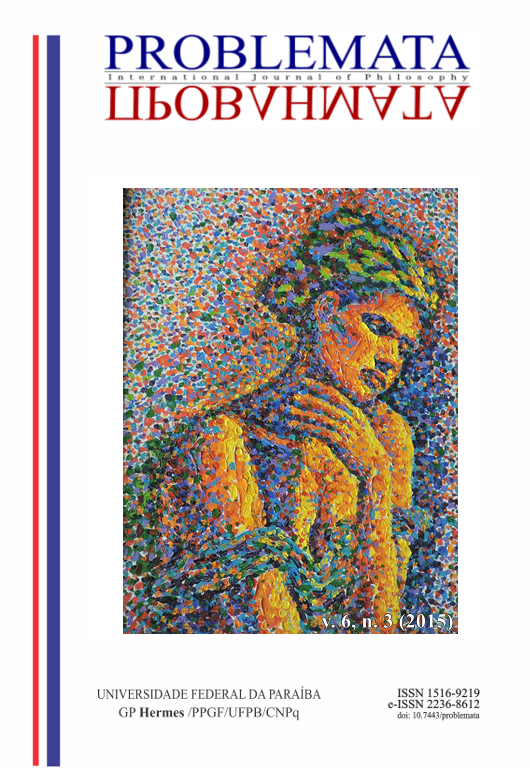A FALÁCIA DA TEORIA DA EXPERIÊNCIA DE WILFRID SELLARS A PARTIR DE UMA NOÇÃO ETOLÓGICA EVOLUTIVA
DOI:
https://doi.org/10.7443/problemata.v6i3.26410Keywords:
Percepção, primatas, etologia.Abstract
Este artigo tem como objetivo argumentar em defesa da hipótese da não necessidade conceitual (entendido enquanto um aparato sígnico exclusivamente humano) para uma experiência perceptiva e consciente da realidade, bem como trazer argumentos contrários a teoria da experiência defendida por Wilfrid Sellars (uma teoria conceitualista, isto é, essencialmente antropocentrista da experiência perceptiva e consciente da realidade). Para a defesa de nossa hipótese, nos utilizamos de estudos realizados na área de etologia, bem como argumentos da grande área da biologia. Entendemos que os resultados de pesquisas atuais em tais áreas colocam em cheque grande parte da teoria da experiência desenvolvida por Sellars, teoria esta que se torna obsoleta devido ao avanço científico, mas que ainda, de modo contínuo, causam discussões intermináveis do âmbito da filosofia. A teoria da experiência de Sellars cai em descrédito no momento em que assumimos a teoria da evolução moderna como verdade. Apontaremos casos em que se pode constatar a ocorrência da percepção consciente em primatas, grupo esse escolhido devido à proximidade genética.
[doi:HTTP://dx.doi.org/10.7443/problemata.v6i3.26410]
Downloads
References
CALL, J.; HARE, B.; CARPENTER, M.; TOMASELLO, M. 'Unwilling' versus 'unable': chimpanzees' understanding of human intentional action. Developmetal Science,Vol 7, N. 1, Pp. 488 – 498, 2004, DOI: 10.1111/j.1467-7687.2004.00368.
HAUSER, M. D.; CHEN, M. K.; CHEN, F.; CHUANG, E. Give unto others: genetically unrelated cotton-top tamarin monkeys preferentially give food to those who altruistically give food back. Proc. R. Soc. Lond., Vol 270, N. 1531, Pp 2363 – 2370, 2003. doi: 10.1098/rspb.2003.2509 B.
KANT, Immanuel. Crítica da razão pura. Lisboa: FundaçãoCalousteGulbenkian, 2001
RIZZOLATI, G.; FOGASSI, L.; GALESSE, V.Neurophysiological mechanisms underlying the understanding and imitation of action. Nature Reviews Neuroscience, Vol: 2, N. 1, Pp. 661 – 670, 2001, DOI: 10.1038/35090060.
SELLARS, W. Empiricism and the philosophy of mind. In: Sellars, W. Science, Perception and Reality . Hypertext by Andrew Chrucky: http://www.ditext.com/sellars/psim.html
______. Philosophy And The Scientific Image Of Man. In: Frontiers of Science and Philosophy,edited by Robert Colodny (Un. of Pittsburgh Press, 1962): 35-78. Reprinted in Science, Perception andReality (1963). Hypertext by Andrew Chrucky, 2000.
______. Ciência Percepcióny Realidad. Madrid: EditorialTecnos, 1971, Tradução de VictorSanchez de Zavala.
______. La filosofía y laimagen científica delhombre. In: Sellars, W. Ciência Percepción yRealidad. Madrid: Editorial Tecnos, 1971, Trad. Victor S. de Zavala. pp. 9-49.
______. Ser y ser objeto de conocimiento. In: Sellars, W. Ciência Percepción y Realidad.Madrid:Editorial Tecnos, 1971, Trad. Victor S. de Zavala. pp. 50-69.
______. Empiricism and the philosophy of mind. In: DeVries, Willem; Triplet, Tim. Knowledge,Mind and the Given. Indianapolis: Hackett Publishing Co., 2000. pp. 205-276.
______. Empirismoe a Filosofia da Mente. Petrópolis:Editora Vozes, 2008 (ColeçãoEpistemologia), Tradução de Sofia I. A. Stein, pp. 23-119.
______.Science and Metaphysics, Variations on Kantian Themes. New York Humanities Press,1968 ; p.1. http://www.ditext.com/chrucky/chru-0.html
______. Autobiographical Reflections:(1973, Published in Action, Knowledge and Reality, editedby H.N. Castañeda (Indianapolis: Bobbs-Merrill, 1975): 277-93. Hypertext by Andrew Chrucky, June10, 1999.
______.CHISHOLM, R. Intentionality and the Mental: Chisholm-Sellars Correspondence onIntentionality. (University of Minnesota Press, 1957): Hypertext by Andrew Chrucky, 2001.http://www.ditext.com/sellars/sccor-f.html
______. Empiricism and the Philosophy of Mind,in: Science, Perception and Reality, Atascadero: Ridge,1991.
______. “Some remarks on Kant's Theory of Experience”. The Journal of Philosophy 64, 20: 633-647, 1967.
UNIVERSITY OF UTAH. "The Oldest Homo sapiens ((Linnaeus, 1758): Fossils Push Human Emergence Back To 195,000 Years Ago." ScienceDaily. ScienceDaily, fevereiro de 2005.
WOOD, Justin N.; GLYNN, David D.; PHILIPS, Brenda C.; Hauser, MARC D. The Perception of Rational, Goal-Directed Action in Nonhuman Primates. Science,Vol.. 317, N. 5843, Pp. 1402 – 1405 , 2007, DOI: 10.1126/science.1144663.
Downloads
Published
Issue
Section
License
Authors who publish with this journal agree to the following terms:
- Authors retain copyright and grant the journal right of first publication with the work simultaneously licensed under a Creative Commons Attribution License that allows others to share the work with an acknowledgement of the work's authorship and initial publication in this journal.
- Authors are able to enter into separate, additional contractual arrangements for the non-exclusive distribution of the journal's published version of the work (e.g., post it to an institutional repository or publish it in a book), with an acknowledgement of its initial publication in this journal.
-
- Authors are permitted and encouraged to post their work online (e.g., in institutional repositories or on their website) prior to and during the submission process, as it can lead to productive exchanges, as well as earlier and greater citation of published work (See The Effect of Open Access).





